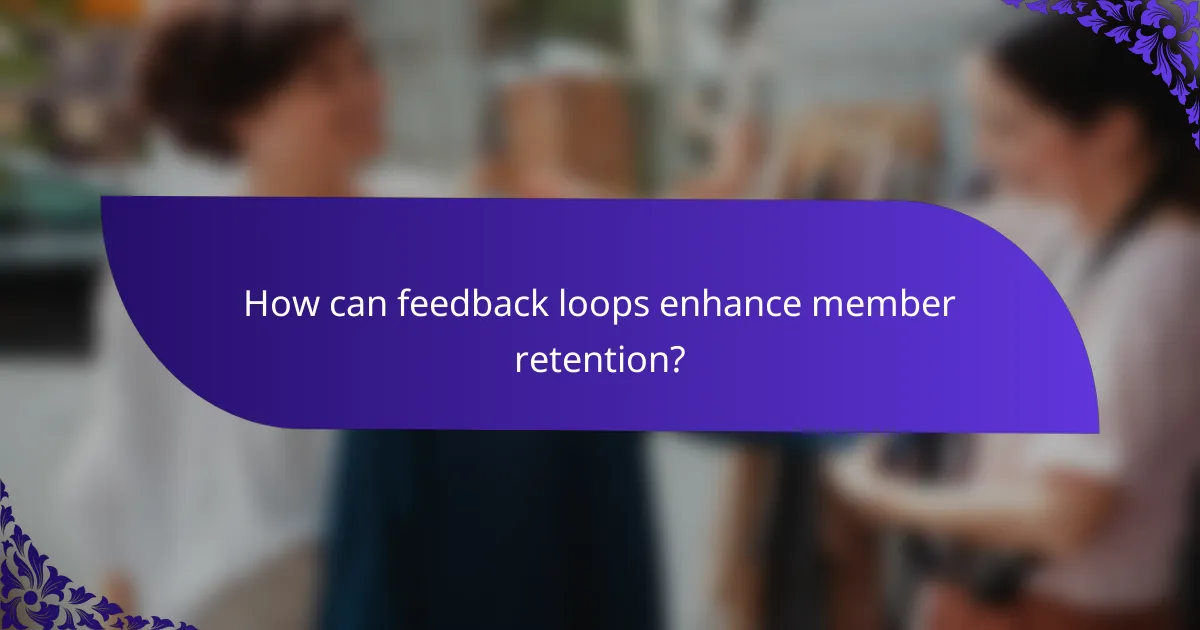Utilizing feedback loops is a powerful strategy for improving member retention by promoting ongoing communication and engagement. By actively soliciting and responding to member feedback, organizations can tailor their offerings to better meet the needs and preferences of their members, ultimately fostering stronger relationships and enhancing satisfaction.

How can feedback loops enhance member retention?
Feedback loops can significantly enhance member retention by fostering continuous communication and engagement. By actively seeking and responding to member input, organizations can create a more personalized experience that meets the evolving needs of their members.
Continuous engagement through surveys
Regular surveys are a vital tool for maintaining continuous engagement with members. By asking for feedback on various aspects of the membership experience, organizations can identify areas for improvement and gauge member satisfaction. Aim to conduct these surveys quarterly to keep the feedback fresh and relevant.
To maximize participation, keep surveys brief and focused, ideally taking no more than 5-10 minutes to complete. Consider offering small incentives, such as discounts or exclusive content, to encourage responses.
Personalized communication strategies
Personalized communication is essential for making members feel valued and understood. Use the insights gathered from feedback loops to tailor messages based on member preferences, behaviors, and demographics. For example, segment your audience and send targeted emails that address specific interests or concerns.
Implementing automated communication tools can help streamline this process. Ensure that your messages are timely and relevant, such as sending reminders for upcoming events or personalized recommendations based on past interactions.
Data-driven decision making
Utilizing data from feedback loops allows organizations to make informed decisions that enhance member retention. Analyze trends and patterns in the feedback to identify common pain points or areas of success. This data-driven approach can guide strategic initiatives and resource allocation.
Establish key performance indicators (KPIs) to measure the effectiveness of changes made based on feedback. Regularly review these metrics to ensure that your strategies are positively impacting member retention and adjust as necessary to stay aligned with member needs.

What are effective feedback loop strategies?
Effective feedback loop strategies involve systematically gathering and analyzing member input to enhance retention. By implementing structured methods to collect feedback, organizations can identify areas for improvement and foster stronger member relationships.
Regular member feedback surveys
Regular member feedback surveys are a straightforward way to gauge satisfaction and gather insights. These surveys can be conducted quarterly or biannually, allowing members to express their opinions on various aspects of the organization, such as services, communication, and overall experience.
To maximize response rates, keep surveys concise and focused, ideally taking no more than 5-10 minutes to complete. Consider offering incentives, like discounts or exclusive content, to encourage participation.
Focus groups for in-depth insights
Focus groups provide a platform for deeper discussions among a select group of members. These sessions can uncover nuanced opinions and feelings that surveys may miss, allowing organizations to explore specific topics in detail.
When organizing focus groups, aim for 6-10 participants to ensure a manageable discussion. Prepare open-ended questions to facilitate conversation and consider recording sessions for later analysis. This qualitative data can be invaluable for understanding member needs and preferences.
Utilizing Net Promoter Score (NPS)
Net Promoter Score (NPS) is a widely used metric that measures member loyalty and satisfaction. By asking members how likely they are to recommend your organization to others on a scale from 0 to 10, you can categorize them into promoters, passives, and detractors.
Regularly tracking NPS can help identify trends over time. Aim for a score above 50 to indicate strong member loyalty. Use follow-up questions to understand the reasons behind the scores, allowing you to address concerns and enhance the overall member experience.

How to implement feedback loops in membership programs?
Implementing feedback loops in membership programs involves systematically gathering member insights to enhance retention strategies. This process allows organizations to understand member needs and preferences, leading to improved engagement and satisfaction.
Step 1: Establish clear objectives
Setting clear objectives is crucial for effective feedback loops. Define what you aim to achieve, such as increasing member satisfaction, reducing churn rates, or enhancing service offerings. These objectives will guide the type of feedback you seek and how you measure success.
Consider using the SMART criteria—Specific, Measurable, Achievable, Relevant, and Time-bound—to formulate your objectives. For example, aim to increase member retention by 15% over the next year by addressing common pain points identified through feedback.
Step 2: Choose appropriate feedback channels
Selecting the right feedback channels is essential for gathering valuable insights. Common channels include surveys, focus groups, social media, and direct interviews. Each channel has its strengths; for instance, surveys can reach a larger audience quickly, while focus groups provide deeper qualitative insights.
Consider your target demographic when choosing channels. For example, younger members may prefer digital surveys, while older members might respond better to phone interviews. Aim for a mix of channels to capture diverse perspectives and ensure comprehensive feedback.
Step 3: Analyze and act on feedback
Once feedback is collected, analyze it to identify trends and actionable insights. Look for common themes in member responses and prioritize issues that align with your established objectives. Tools like sentiment analysis or simple categorization can help streamline this process.
After analysis, develop an action plan to address the feedback. Communicate changes to your members to show that their input is valued and leads to tangible improvements. For example, if members express dissatisfaction with a specific service, consider enhancing that service based on their suggestions.

What tools can facilitate feedback loops?
Effective feedback loops can be enhanced using various tools that streamline communication and data collection. Utilizing the right platforms can help gather insights, track member behavior, and facilitate real-time discussions, ultimately improving member retention.
SurveyMonkey for member surveys
SurveyMonkey is a powerful tool for conducting member surveys, allowing organizations to gather valuable feedback efficiently. By designing targeted surveys, you can assess member satisfaction, preferences, and areas for improvement.
To maximize response rates, keep surveys concise and focused. Aim for a completion time of under five minutes, and consider offering incentives for participation, such as discounts or exclusive content.
Slack for real-time communication
Slack serves as an excellent platform for real-time communication among members and staff. It enables instant messaging, file sharing, and the creation of channels dedicated to specific topics or projects.
Encourage members to share their thoughts and experiences in designated channels. This fosters a sense of community and allows for immediate feedback, which can be invaluable for making quick adjustments to programs or services.
Google Analytics for behavior tracking
Google Analytics is essential for tracking member behavior on your website or app. It provides insights into user engagement, popular content, and drop-off points, helping you understand how members interact with your offerings.
Set up goals and conversion tracking to measure specific actions, such as newsletter sign-ups or event registrations. Regularly review this data to identify trends and make informed decisions that enhance member retention strategies.

What metrics indicate successful member retention?
Successful member retention can be gauged through various metrics that reflect how well an organization keeps its members engaged and satisfied. Key indicators include churn rate, member engagement scores, and retention rate comparisons, each providing insights into different aspects of member loyalty.
Churn rate analysis
Churn rate measures the percentage of members who leave over a specific period. A lower churn rate indicates better retention, while a higher rate signals potential issues with member satisfaction or engagement. Organizations should aim for a churn rate in the low single digits, as this typically reflects a healthy membership base.
To analyze churn effectively, segment the data by demographics or membership types. This can reveal patterns, such as higher churn among certain age groups or service tiers, allowing targeted interventions to improve retention.
Member engagement scores
Member engagement scores assess how actively members interact with the organization’s offerings. High engagement often correlates with lower churn rates, as engaged members are more likely to feel a sense of belonging. Consider using surveys or activity tracking to gauge engagement levels.
Scoring can be based on participation in events, usage of services, or feedback submissions. Regularly monitoring these scores can help identify trends and areas needing improvement, ensuring members remain invested in the community.
Retention rate comparisons
Retention rate comparisons involve evaluating your organization’s retention against industry benchmarks or historical performance. This metric helps determine if your retention strategies are effective or if adjustments are needed. Aim to maintain retention rates above 80% for most membership organizations.
When comparing retention rates, consider factors like seasonality or economic conditions that may impact member behavior. This context can provide a clearer picture of your retention success and guide future strategies.

How do feedback loops compare to traditional retention methods?
Feedback loops focus on continuous improvement through member input, while traditional retention methods often rely on static strategies. By actively engaging members and adapting to their needs, organizations can enhance retention more effectively than with one-size-fits-all approaches.
Proactive vs. reactive approaches
Proactive approaches involve anticipating member needs and addressing potential issues before they arise. This can include regular surveys or check-ins to gather insights and make adjustments accordingly. In contrast, reactive methods typically respond to problems after they occur, which may lead to member dissatisfaction and increased churn.
For example, a proactive method might involve implementing a quarterly feedback survey, while a reactive approach might only address concerns raised during exit interviews. By prioritizing proactive strategies, organizations can foster a more engaged and loyal membership base.
Member-centric vs. organization-centric
Member-centric feedback loops prioritize the needs and preferences of members, ensuring that their voices shape the organization’s offerings. This approach can lead to higher satisfaction and loyalty, as members feel valued and heard. On the other hand, organization-centric methods focus on internal metrics and goals, which may overlook member experiences and lead to disengagement.
For instance, a member-centric strategy might involve tailoring services based on direct feedback, while an organization-centric approach might push initiatives based solely on internal data. Shifting to a member-centric model can significantly improve retention rates.
Long-term benefits of feedback integration
Integrating feedback loops into retention strategies offers long-term benefits, including improved member satisfaction and loyalty. By continuously refining offerings based on member input, organizations can create a more appealing experience that encourages long-term commitment. This ongoing dialogue can also help identify trends and emerging needs, allowing for timely adaptations.
Moreover, organizations that embrace feedback integration often see enhanced community engagement and advocacy. Satisfied members are more likely to refer others, contributing to organic growth. Establishing a culture of feedback can lead to sustained success in member retention over time.


